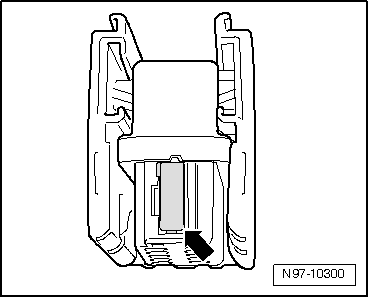Volkswagen Golf Service & Repair Manual: Secondary locking element
| The secondary locking mechanism is a housing catch (second
line locking mechanism) that secures all the wires in one
contact housing. If a secondary locking mechanism is fitted to a
contact housing, this must always be opened or removed using the
appropriate tool before releasing and pulling out individual
crimp contacts. |
| The secondary locking mechanism is different in colour from
the rest of the contact housing. This makes it easier to
identify the secondary locking mechanism and clarifies its
intended function. |
| The types of contact housing shown here are just a few
examples to show the different functions of secondary locking
mechanism. |
|
|
|
| The housing catch is disengaged by removing a “toothed
element”-arrow-. |
|
|

|
| The housing catch is disengaged by opening a “flap”-arrow-. |
|
|

|
| The housing catch can be disengaged by detaching a “slide”-arrow-. |
|
|

|
Note
Observe the general notes on repairs to the vehicle
electrical system
→ Chapter.
To release, always ...
The primary locking mechanism is what fixes an individual
crimp contact in the contact housing.
If necessary, any housing catches in place (secondary ...
© 2016-2025 Copyright www.vwgolf.org

 Notes on releasing and dismantling contact housings
Notes on releasing and dismantling contact housings Primary locking element
Primary locking element


